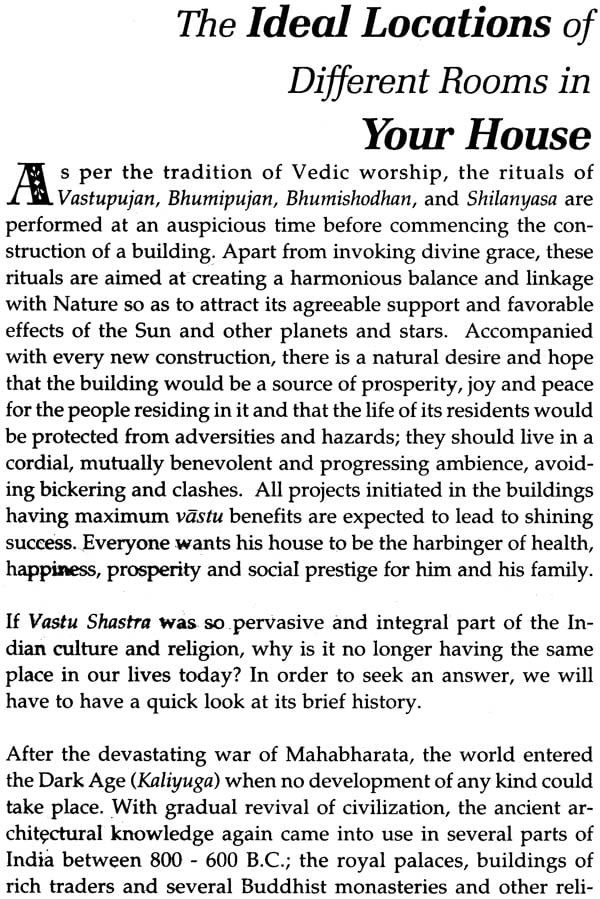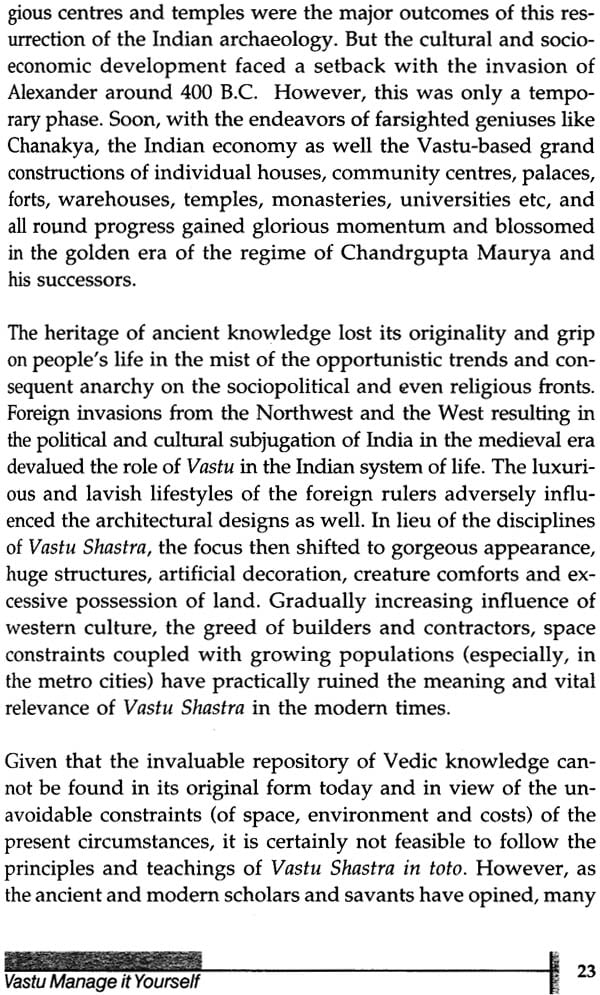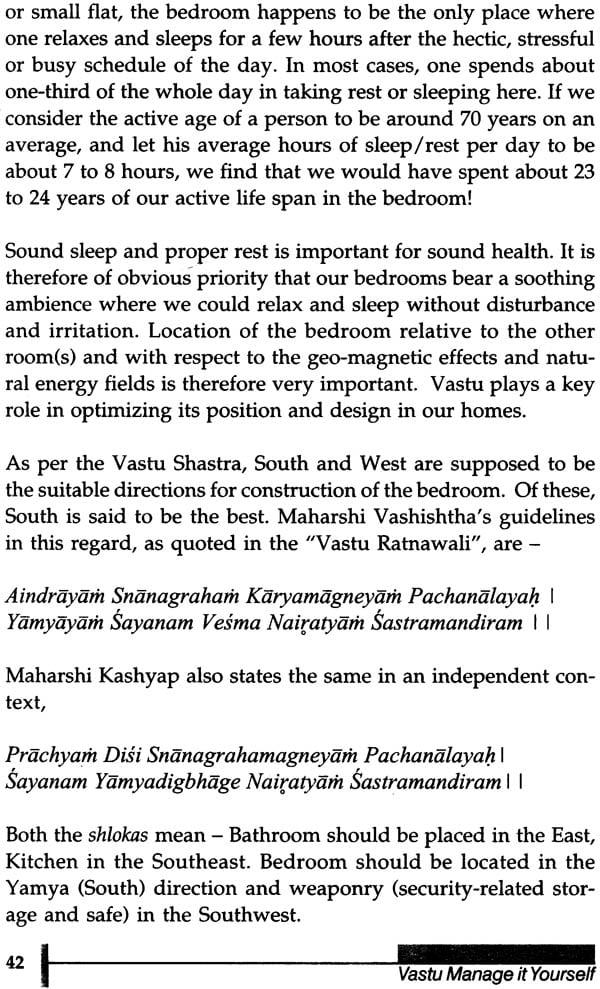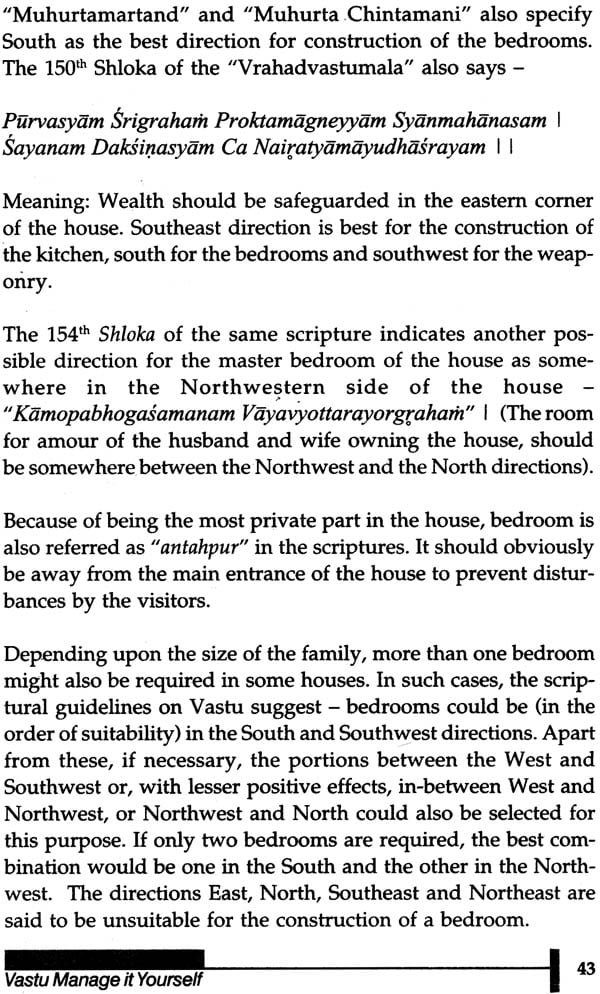
Vastu (Manage it Yourself)
Book Specification
| Item Code: | NAF394 |
| Author: | Dr. Rajani Joshi |
| Publisher: | Shri Vedmata Gayatri Trust, Shantikunj, Haridwar |
| Language: | English |
| Edition: | 2007 |
| ISBN: | 8182550230 |
| Pages: | 48 |
| Cover: | Paperback |
| Other Details | 8.5 inch x 5.5 inch |
| Weight | 70 gm |
Book Description
Pandit Shriram Sharma Acharya, a pioneer of spiritual renaissance was born on 20th September 1911, in Anwalkheda, Agra District. He met his Guru, a great Himalayan Yogi, when he was only 15 years of age and scrupulously carried out his biddings throughout his life.
He took part in the struggle of independence as a volunteer, went to jail a number of times and embarked upon the task of social and moral upliftment through spiritual means in 1935 with the blessings of Mahatma Gandhi.
A sage, a visionary and a reformer, the Acharya initiated 100 point Yug Nirman Yojna, lived a disciplined life of devout austerity, visited the Himalayas several times and attained spiritual eminence.
The Gayatri Pariwar fraternity; Shantikunj Ashram an academy for moral and Spiritual awakening; Brahmavarchas research Institute which strives to synthesize science with spirituality and over 3000 social reform centre’s (Shakti-peeths are his greatest contributions of the modern world.
He translated the entire Vedic Vangmaya and accopmplished a feat of writing more than 3000 books on all aspects of life.
The Acharya, Great devotee of Gayatri lived an ideal life for 80 years and voluntarily shed his physical sheath on Gayatri Jayanti, 2nd June 1990.
Nature has potentially endowed man with the faculty of delving deep into its secrets to be able to ensure good health, happiness and soul progression. The cultivation is a never-ending process, though the momentum, depending upon several factors, keeps on changing. Vastu (vastu) is one such field of occult knowledge that was recognized by the Indian sages (rishis) as the vibratory force of Nature hidden in one’s residence and its surroundings. With the increasing curiosity and fascination of people, past few years have witnessed a mushrooming of popular lectures, books and web sites on this holistic discipline of architectural principles. However because of a commercial approach to exploit mass psychology, there seems to be proliferation of misconceptions or half-knowledge about this important subject. This book presents excerpts of authentic knowledge from the Vedic scriptures on “Vastu Shastra’’ to acquaint the reader with the underlying principles of Vastu with practical guidance for its application.
Our life is sensitive to not only the environment and the am bience around, but also to the structure and designs of the residence we live in and the type and topography of the plot of earth on which it is built. The rishis were well aware of this fact and had therefore linked the knowledge of architecture and interior and exterior design of residence with the science of vastu and had developed it as a Vedic discipline of knowledge, collectively known as the “Vastu Shastra’’ (Vastu Shastra). Many of the ancient temples stand as living monuments of the awe-in-spiring majesty and inspiration emanating from these magnificent houses of worship built according to the Vastu Shastr.
Vastu Shastra is counted among the sixty-four principal faculties of Knowledge, which emanated directly from the Vedas. Several hymns or formulae in the Rigveda and Yajurveda pertain to the origin of Vastukala (architectural and constructional art). Like the four Vedas there are four Up-vedas, namely, Gandharveda, Dhanurveda, Ayurveda and Sthaptyaveda. Of these, the last one happens to be what was developed as the Vastu Shastra in the successive ages – the period of the vedic scriptures like the Brahmans, Aranyaks, Upanishads and Puranas. The subsequent post-vedic times of the Ramayana and Mahabharata are believed to be the period when this knowledge (of Vastu) was deciphered and disseminated in its most evolved and practicable form. The planning and architecture in the grand cities of Lanka, Ayodhya, Hastinapur, Dwarika in that era are regarded as exemplary monuments of Vastukala.
A house provides shelter to someone or the other and hence it is given the importance of a sacred activity in the Indian Culture and is counted as a part of Dharma. “Vrahad Vastumala” – a scripture of the Vastu Shatra, highlights the purpose of house construction as -
Striputradikabho Aranya, Jananam Dharmarthakama Puram
Jantunamayanam Sukhasyadamidam, Sitambu Dharmahm
Meaning: House (Home) is that which offers the worldly joys of having a family, keeping pets, cattle, etc; which protects from cold, heat, storms and other external hazards, and which facilitates the proper performance on dharma (righteous duties), artha (attainment of wealth/material power and progress) and kama (fulfillment of desires).
The savants of Vastu Shastra affirm that a house constructed according to the norms and guidelines of this vedic science, helps allay the tensions and minimize the chances of familial conflicts and stresses arising out of economic problems, social pressures, sickness, etc. “Vishwakarma Prakash” states that – “The divine power of Vastu is pervading everywhere on the earth, on which Lord Vastu is subliminally lying with his face towards North-East Direction (Purvottarmikho Vastu Purusah Parikalpitah). A house built as per the vedic instructions of “Vastu Shastra” is blessed by the grace of Lord Vastu and thus lends enormous support in the progess and happiness of the people residing therein.
The worship of Lord Vastu, along with other manifestations of God, is an integral part of Deva Pujana in the major sacraments and religious ceremonies of the Hindu Dharma. This signifies the subliminal presence of divine powers and energies inherent in the five basic elements (the panca tatvas) and hence in the visible and invisible forces of Nature and stresses the maintenance of a harmonious balance between them in all activities of life.
Vastu Shastra is believed to be the oldest science of Architecture. It is literally defined as – the Shastra (a branch of Vedic Literature), which deals with the knowledge of the topography and the design of any construction to be built for residence, worship or any other purpose. The word “vastu in Sanskrit language is derived from the verb “vasa” which means living, residing , lodging, etc. the word ‘vastu is defined in Amara Kosha”.
| 1 | Vastu Shastra - An Introduction | 7 |
| 2 | The Importance of Northeast Angle in Vastu Shastra | 15 |
| 3 | The Ideal Locations of Different Rooms in Your House | 22 |
| 4 | Best Position of Kitchen in Your House | 28 |
| 5 | Some Guidelines on Arrangements inside the Kitchen | 34 |
| 6 | Vastu Guidelines on Badrooms | 41 |
| 7 | Concluding Reminder | 47 |









